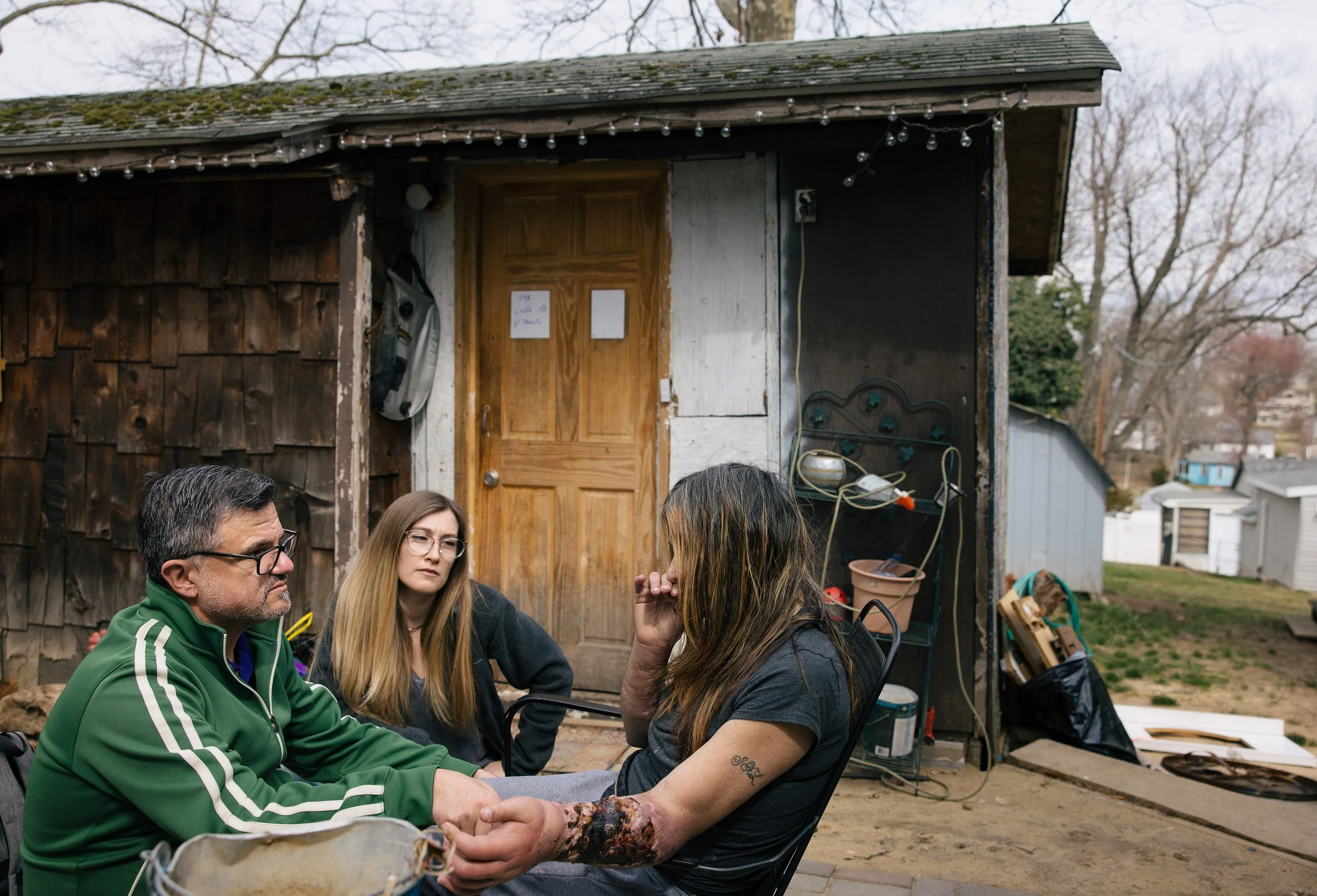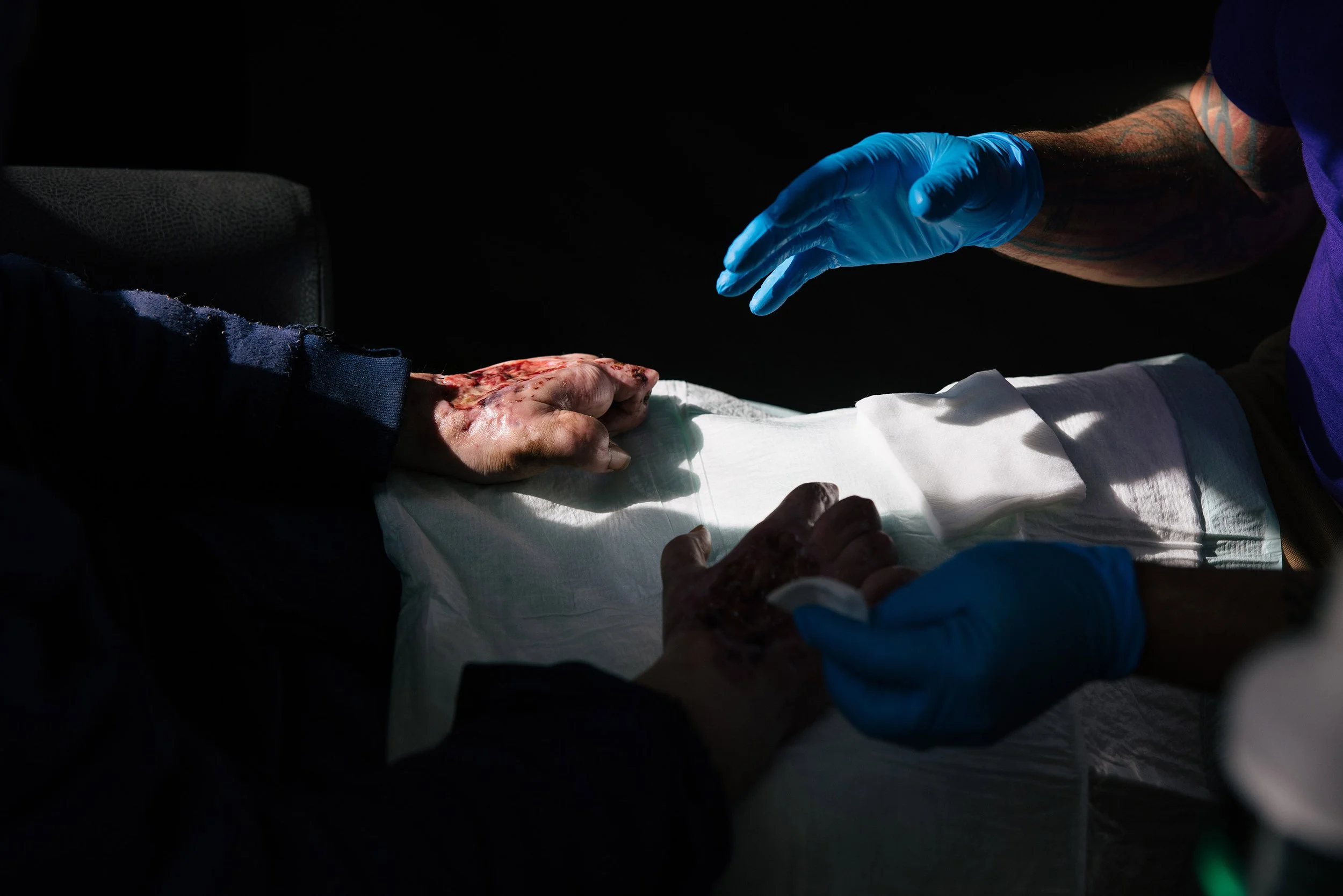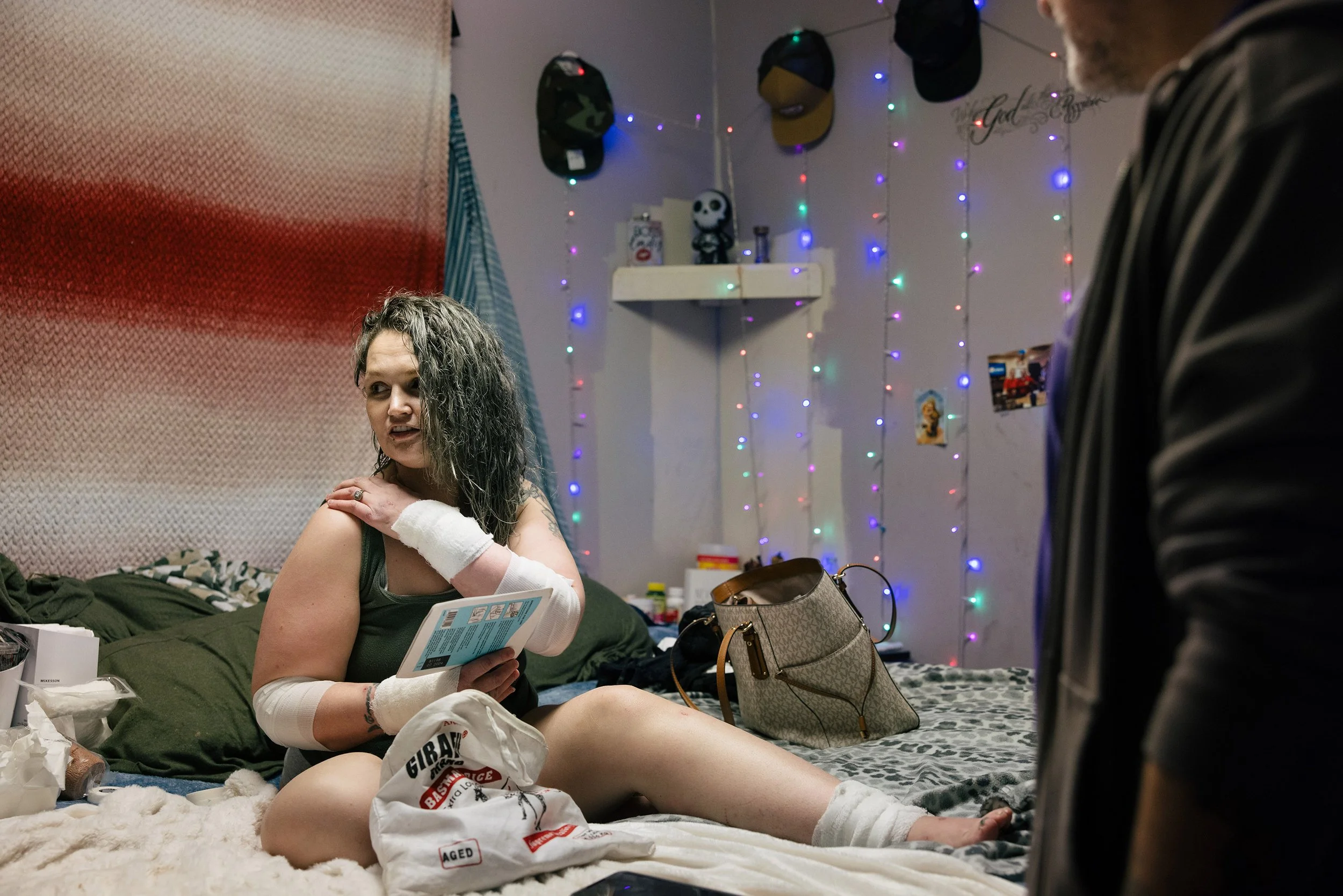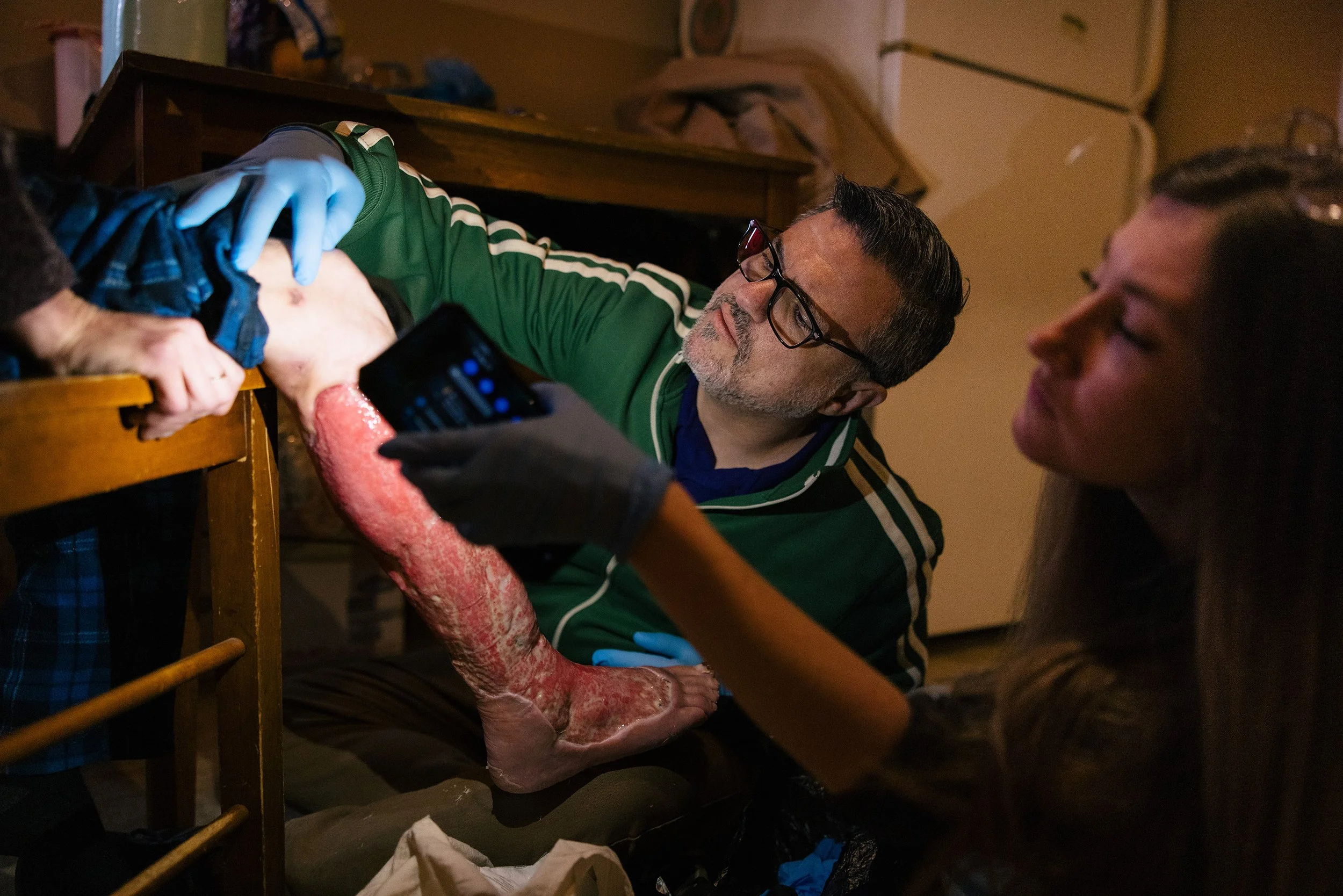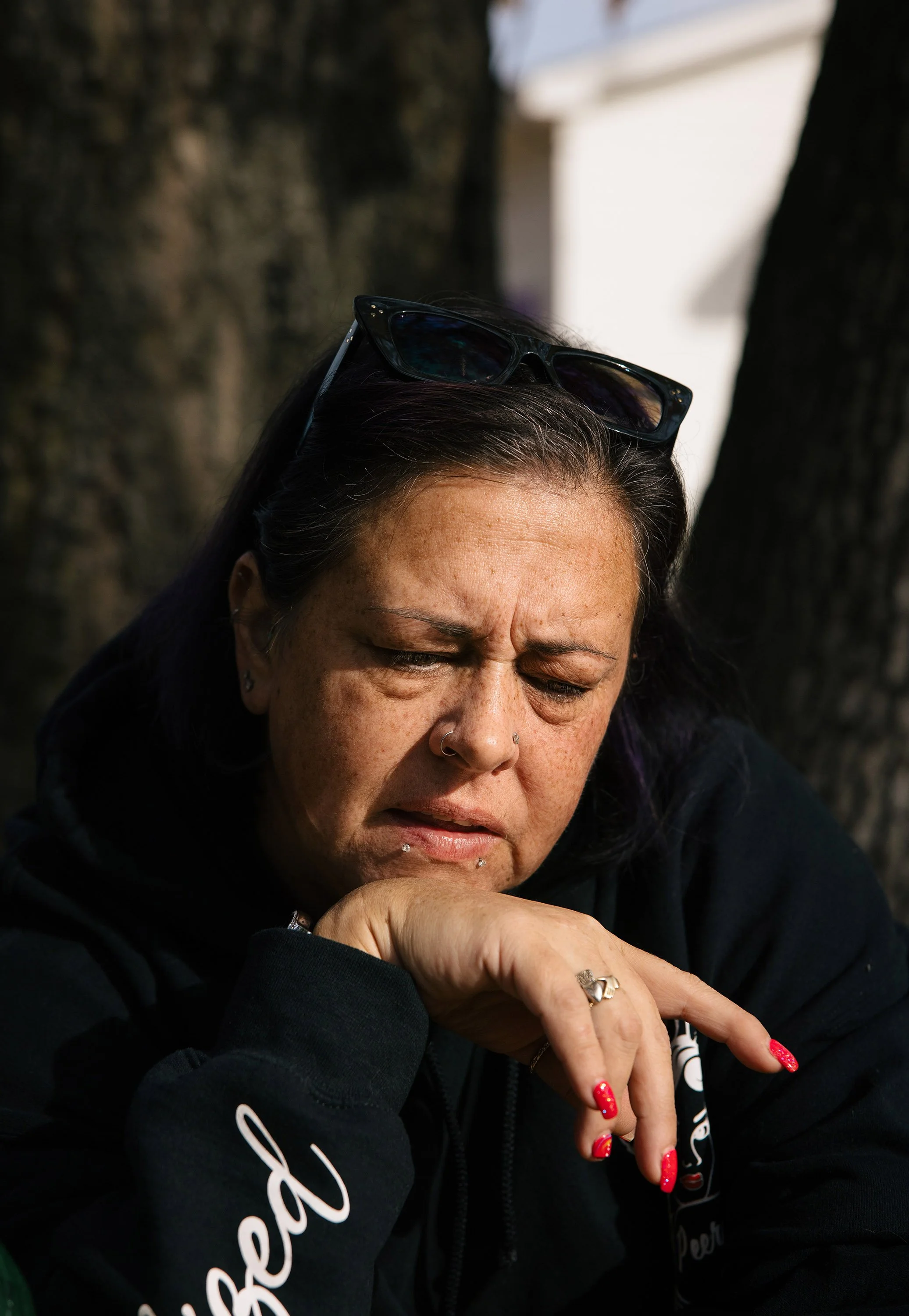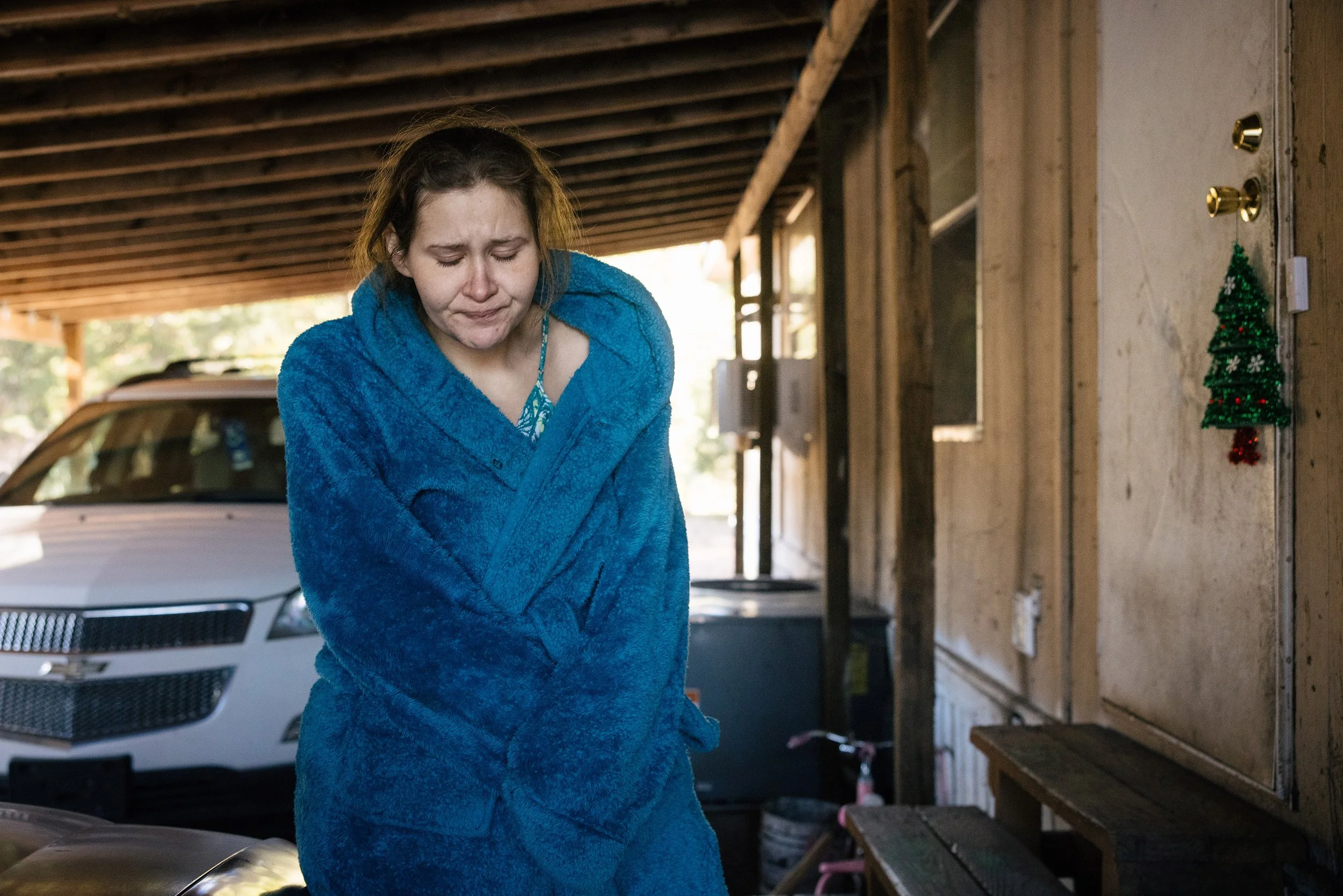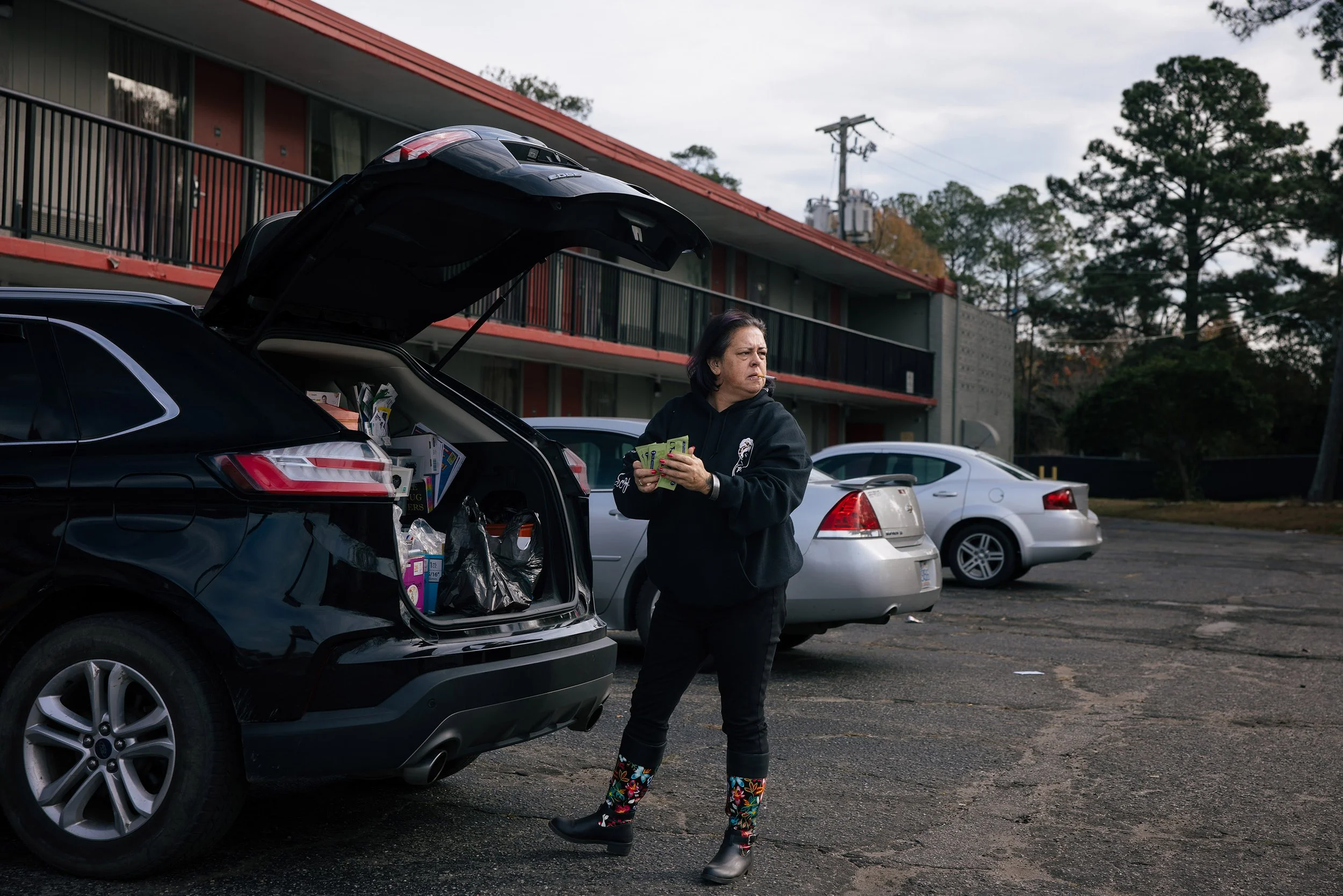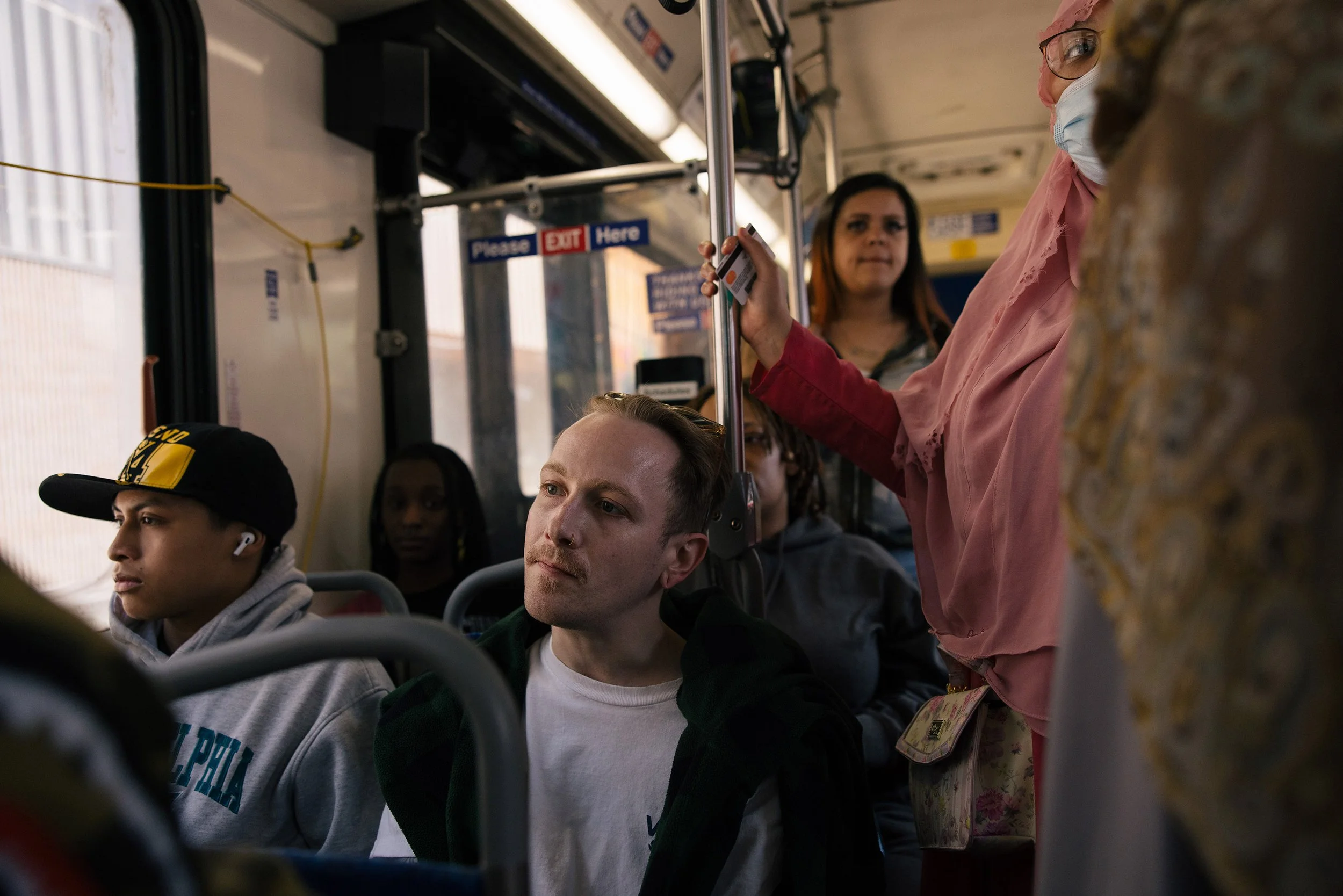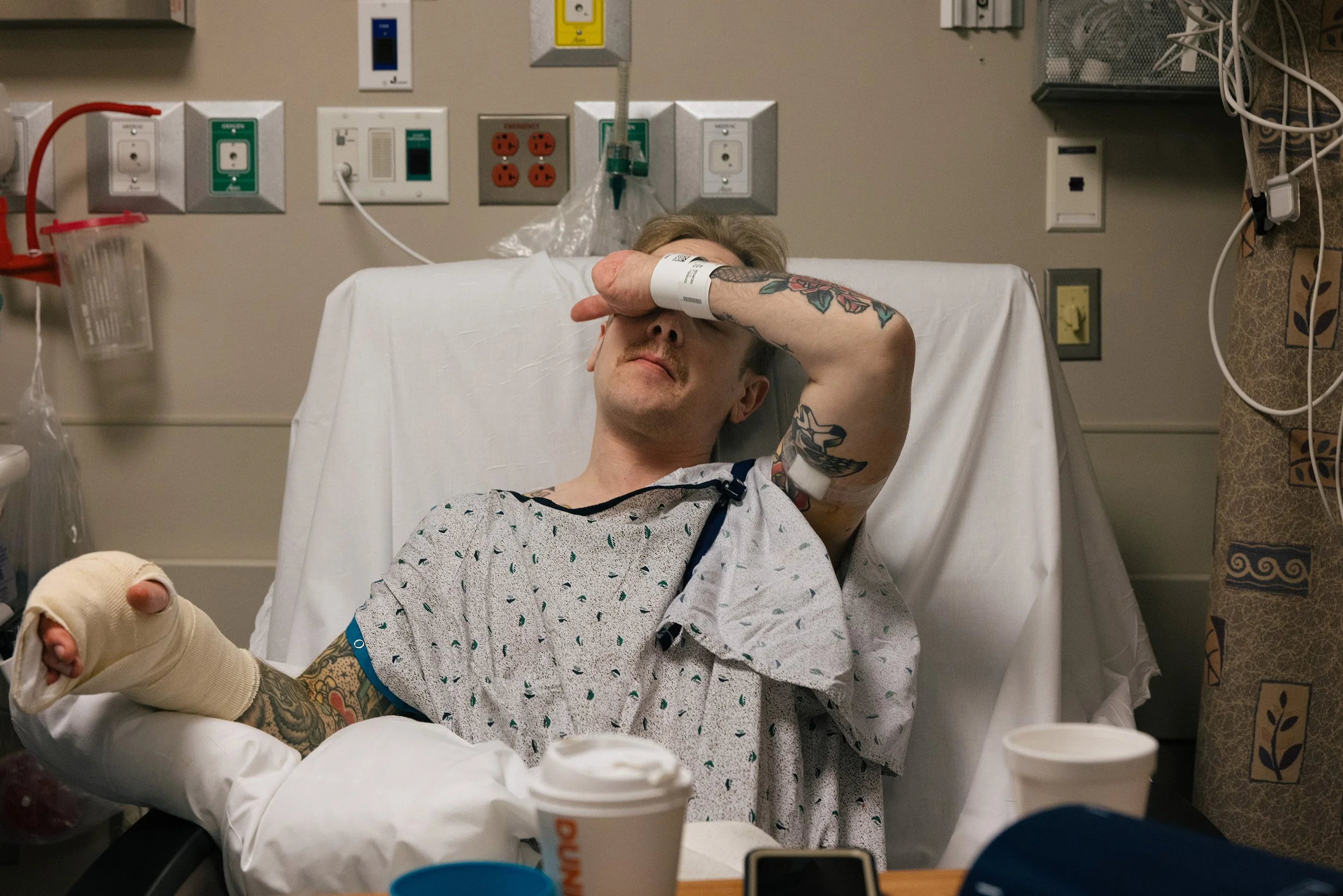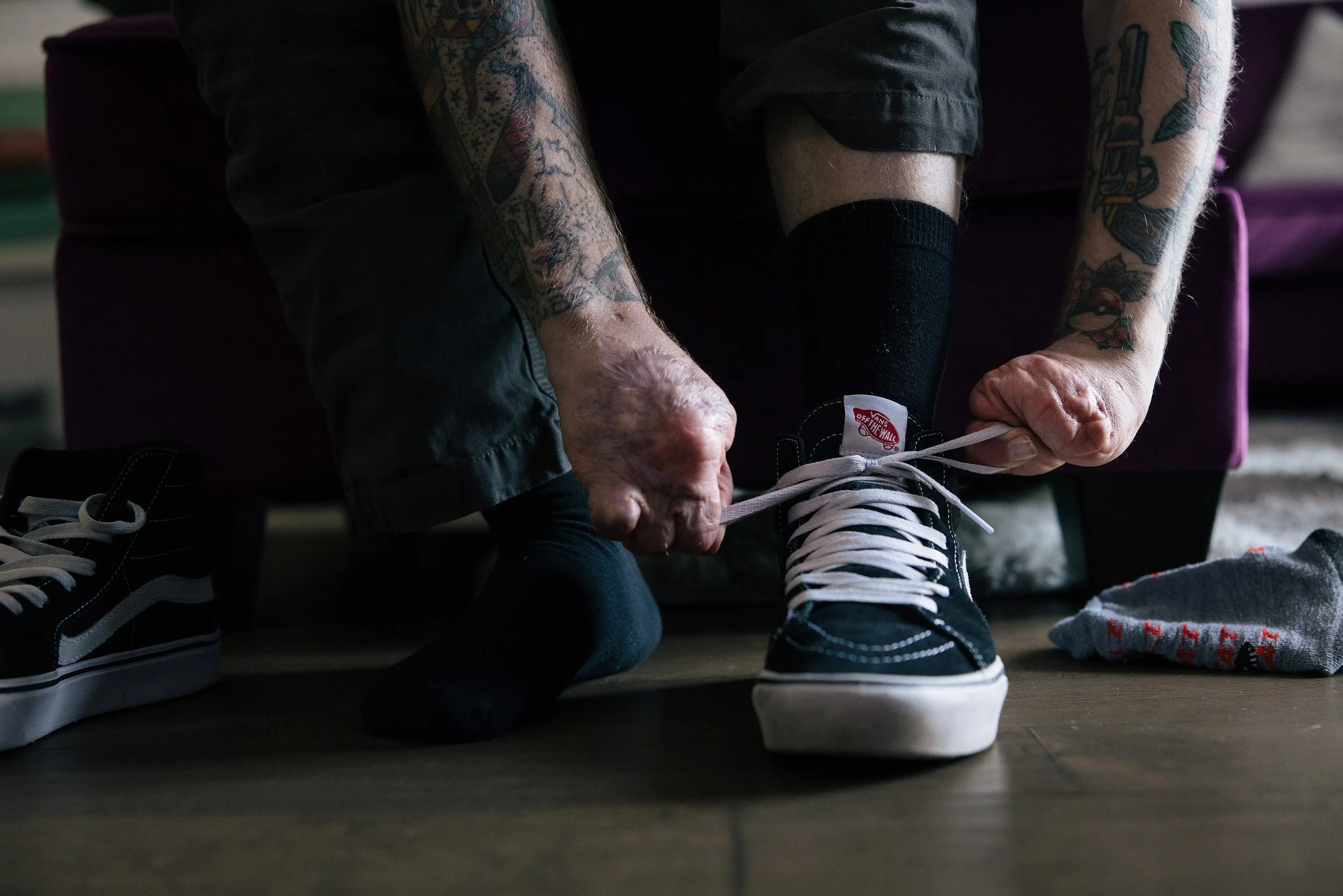Flesh-Rotting ‘Tranq’ Ushers In a Dire Era in the Opioid Crisis
The opioid crisis has morphed into something even scarier: a variable, volatile mix of addictive substances. Powerful chemicals meant to mimic or enhance the effects of fentanyl, cocaine and methamphetamine are making America's drug supply deadlier and less predictable than ever.
Leading the wave is xylazine, an animal tranquilizer that knocks people out for hours, makes it harder to revive them and produces rotting wounds that can lead to amputation and death. Harm reduction workers who distribute supplies and resources in hard-hit communities are a lifeline for people caught up in a deadly addiction cycle.
Trigger warning: the story below contains graphic images that may not be suitable for all audiences.
Photographed for the Wall Street Journal
Wound care nurse Jason Bienert wrapped xylazine wounds on the hands of Nathan Clark, 28, a longtime opioid user, in Elkton, Md. on February 8, 2023. Despite the toll xylazine had exacted on his body, Clark said he couldn’t stop using it. Stopping xylazine use would send him into brutal withdrawal, he said.
“The xylazine is literally tearing me apart,” he said. “I don’t have skin on the top of my hands. You can see my tendons. You can see my bones.”
Clark recently had both legs and his left arm amputated. His doctors think he could be a strong candidate for a prosthetic hand. But he doesn’t want to spend that much time in medical care.
Bienert and Peters brought medical supplies to the home of Tina Hutchins, 35, in Elkton, Md., on March 2, 2023, so she could continue caring for herself. A dozen new xylazine wounds had spread across her arms and legs. One on her foot needed additional care, but she was hesitant to visit a doctor.
“The hospitals treat addicts so bad,” she said. A doctor who had lanced a wound two months earlier was rude to her, she said.
Hutchins, a mother of three, overdosed and died on October 23, 2023.
Jason Bienert and Kayla Peters cared for Beau LaPoint, a longtime drug user, was recuperating from the treatment of xylazine wounds. To cover dead tissue, a surgeon had removed the skin from her shin and calf, laying bare the flesh below.
Bienert examined her exposed flesh. LaPoint should have been recovering in a hospital, Bienert said. Many people addicted to opioids leave hospitals rather than go through withdrawal while they can’t use drugs. The paperwork from LaPoint’s hospital stay called for wound care and physical therapy, but she didn’t have a car or a way to reach appointments.
The nurses identified a fresh xylazine wound on LaPoint’s knee. Bienert showed LaPoint how to care for the damaged skin. “I don’t know what I’d do without him,” she said.
North Carolina Harm Reduction Coalition, the nonprofit that employed Collins-Caddle, didn’t renew her annual contract in December. Collins-Caddle said she would continue helping people who ask for it. “They’re not going to stop calling me just because I stop doing this job,” she said. “This isn’t a job at Walmart.”
Carisa Collins-Caddle, left, hugs Regina Locklear outside the tent where Locklear was living with two other people, in Pembroke, N.C. on December 7, 2023.
Weeks earlier, a wound that appeared on Locklear’s arm after she injected illicit drugs had swelled to the size of an orange. She texted a photo to Collins-Caddle, who provides help including clean syringes to drug users. Collins-Caddle had been spreading the word of xylazine’s arrival in North Carolina’s drug supply.
“I never thought there would be a day when I would say there was something that scared me more than fentanyl. But here I am,” said Collins-Caddle.
Ashley Locklear opened the bottom of her bathrobe to reveal legs riddled by xylazine scars on December 7, 2023 in Pembroke, N.C.
“It just keeps getting bigger,” she said. “I wasn’t having problems with my hands, and now I’m having problems with my hands.”
Locklear started taking opioids at 13. Doctors prescribed them after she broke her foot. She moved from illicit pills to other illicit drugs. Recently they had become laced with xylazine.
Locklear's health has continued to decline. Wounds on her hands and legs have deteriorated. Her mother, Kelly Locklear, wants her daughter to go seek help. Ashley refuses to go to the hospital, fearful of withdrawal from fentanyl and xylazine.
"She's going downhill quickly," Kelly Locklear said. "All I can do is love her through it all."
Collins-Caddle distributed supplies to drug users in Lumberton, N.C., on December 8, 2023. “My hair started falling out a couple of months ago,” she said. “That’s how stressed out I am.”
Collins-Caddle grew up in a family marked by addiction and abuse. Marijuana and alcohol opened a door to cocaine and crack. In her mid-20s, she tried opioids for a migraine. It filled a hole for her, she said. She has been in recovery for nearly nine years after using drugs including opioids for 17 years.
About a third of Robeson residents fall below the federal poverty line, and the county ranks last in the state for health outcomes. Many homes in the area were wrecked by Hurricanes Matthew and Florence over the past decade.
David “Lee” Wells rode a bus to his home in Philadelphia after receiving a prosthetic hand, on May 18, 2023. Wells lost five fingers after using fentanyl mixed with xylazine, the prosthetic gave him the confidence to ride without fearing the stares of his fellow passengers.
His surgeons said they had never seen a patient come back in stable recovery from xylazine. He began taking Suboxone, an anti-addiction medication, and started treatment for depression. After six months on a waiting list, he had his first therapy appointment in May 2023. His recovery included a prosthetic and dentures, which he used to chew his first steak in years. Treatment has kept him stable for nearly two years.
“I wanted help. I wanted to get out,” he said.
Dr. Adam Strohl and Dr. Matthew Wilson prepared for surgery to improve the dexterity of David “Lee” Wells’s right hand at Jefferson Methodist Hospital in Philadelphia on May 25, 2023. Alyssa’s experience in other operating rooms convinced the hospital to let her photograph Lee’s transformation.
Wells, 31, didn’t go looking for xylazine. One day, it showed up in his bag of dope. Soon he needed it. The tranquilizer would knock him out for hours, until he woke up sick from withdrawal. When the wounds emerged, the pain overwhelmed him and he wanted to sleep as much as possible. Addiction-treatment centers turned him away because of the complexity of his wounds.
Unable to tolerate withdrawal long enough to have his wounds cared for, Wells left medical care against his doctors’ advice a half-dozen times in 2021. He felt suffocated, nauseous and panicked. Without opioids, the pain in his hands was excruciating. He considered suicide.
“When you’re in it, it doesn’t feel like help is coming,” Wells said.
Wells winced in pain after the surgery. The procedure, one of several to rebuild a hand wasted by xylazine wounds, gave him new dexterity–and self-worth. The organized boy his mom said used to tuck in “everything but his pajamas” is starting to re-emerge. Treatment has kept him stable for nearly two years.
“This is awesome,” he said, the first time he grabbed a small can of Coke.
Wells at home in Philadelphia on May 18, 2023. After losing five fingers, he had to relearn how to tie his shoes.
Lee has continued to live between his family’s home in Texas and his friend’s apartment in Philadelphia. He’s working through his depression and a lack of motivation with his therapist. “For me personally, I had to learn all of my lessons the hard way. It took a lot of suffering,” he said. “I was like you really can’t do this. You’ve got to stop or you’re gonna die.”

